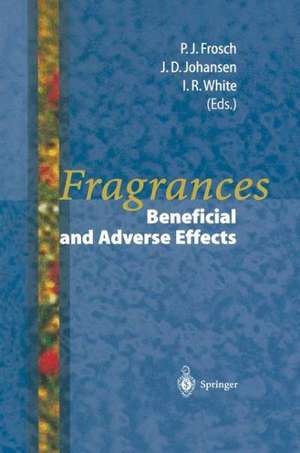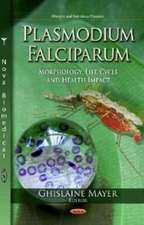Fragrances: Beneficial and Adverse Effects
Editat de Peter J. Frosch Cuvânt înainte de H. Möller Editat de Jeanne D. Johansen, Ian R. Whiteen Limba Engleză Paperback – 13 dec 2011
Preț: 713.91 lei
Preț vechi: 751.47 lei
-5% Nou
Puncte Express: 1071
Preț estimativ în valută:
136.62€ • 148.35$ • 114.76£
136.62€ • 148.35$ • 114.76£
Carte tipărită la comandă
Livrare economică 22 aprilie-06 mai
Preluare comenzi: 021 569.72.76
Specificații
ISBN-13: 9783642803420
ISBN-10: 3642803423
Pagini: 260
Ilustrații: XVIII, 234 p.
Dimensiuni: 155 x 235 x 14 mm
Greutate: 0.37 kg
Ediția:Softcover reprint of the original 1st ed. 1998
Editura: Springer Berlin, Heidelberg
Colecția Springer
Locul publicării:Berlin, Heidelberg, Germany
ISBN-10: 3642803423
Pagini: 260
Ilustrații: XVIII, 234 p.
Dimensiuni: 155 x 235 x 14 mm
Greutate: 0.37 kg
Ediția:Softcover reprint of the original 1st ed. 1998
Editura: Springer Berlin, Heidelberg
Colecția Springer
Locul publicării:Berlin, Heidelberg, Germany
Public țintă
ResearchDescriere
Aromas are an integral part of our civilised society. They are not only used in fine perfumes, but also in numerous other articles with which we have daily contact. Another new development has been the agricultural use of aromas as a "biological weapon" to combat insects and other pests. In the field of dermatology, aromas are today among the most frequent sensitizers and may trigger allergic contact eczemas. This volume presents numerous aspects of the topic for the first time in comprehensive form. In an introduction, the chemistry of frequently used aroma components is described, together with the art of perfume composition that has been refined over the centuries. In a chapter on neuropharmacology, the mechanisms of scent recognition are described in detail.
Cuprins
I: The Basics.- The Art of Creating a Perfume.- Cerebral Representation of Odour Perception.- II: Beneficial Biological Effects.- The Structure, Origin and Function of Human Axillary Odours.- Communication by Odour—The Influence of Body Odour on the Attractiveness of Men.- Orientation of Insects in a Multitrophic System: The Role of Fragrances.- Chemical Signals During Raids by the Robber BeeLestrimelitta limao on Other Stingless Bee Nests (Hymenoptera, Apidae, Meliponinae).- III: Adverse Effects in Humans.- Molecular Aspects of Fragrance Sensitisation.- Identification of Fragrance Sensitizers by QSAR.- Fragrances as a Cause of Contact Dermatitis in Cosmetics: Clinical Aspects and Epidemiological Data.- How Do We Test for Fragrance Allergy?.- Fragrance Hypersensitivity and Its Control.- Are Major Components of Fragrances a Problem?.- Quantitative Aspects in Patch Testing and Usage Tests.- d-Limonene—An Old Perfume Ingredient Introduced as a “Natural” Solvent in Industry: Is There a Risk of Sensitization?.- of Sensitizing Fragrance Materials in Natural Ingredient Based Cosmetics.- RIFM Activities in the Safety Assessment of Systemic Effects of Fragrance Materials.- Absorption of Fragrance Ingredients Using In Vitro Models with Human Skin.- Synthetic, Musk Fragrances in Human Fat and Their Potential Uptake by Dermal Resorption.- IV: Safety Assessment—Predictive Assays for Irritation and Sensitization.- A Reappraisal of the Guinea Pig Maximization Test.- The Hydroxycitronellal Story: What Can We Learn from It?.- The Value of Animal Assays and the Quenching Phenomenon.- In Vitro Phototoxicity Tests for Fragrances.- RIFM Activities in the Safety Assessment of the Dermal Effects of Fragrance Materials.- V: The Producer’s View.- The Producer’s View: Do We Worry About Adverse Effects?.- The IFRA Guidelines.- Fragrances and Environmental Issues: A Case Example of Environmental Risk Assessments of Ingredients.- Fragrances—Future Aspects.
Textul de pe ultima copertă
Fragrances are an integral part of our society. They are used in fine perfumes and in numerous other articles with which we have daily contact. Psychologists have discovered that certain fragrance components of body odour are important in attraction to the opposite sex. Many animals communicate by giving off scents and this is the basis for the agricultural use of fragrances as biological weapons to combat insects and other pests. In the field of dermatology, fragrances are today among the most frequent sensitizers and may trigger allergic contact dermatitis. Dermatologists and fragrance manufacturers are therefore highly motivated to increase their safety for human use. This volume presents numerous aspects of the topic for the first time in comprehensive form. It provides detailed information on recent neuropharmacological and psychosocial findings, chemistry and identification of sensitizers by various assays, and skin absorption studies and environmental issues. International guidelines for manufacturers are provided and commented upon.
Caracteristici
State-of-the art overview by well-known international specialists * Contributions deal with the unwelcome effects of aromas * Up-to-date knowledge on the environmental tolerability of certain aromas due to accumulation in the environment, a problem area receiving increasingly frequent attention,










